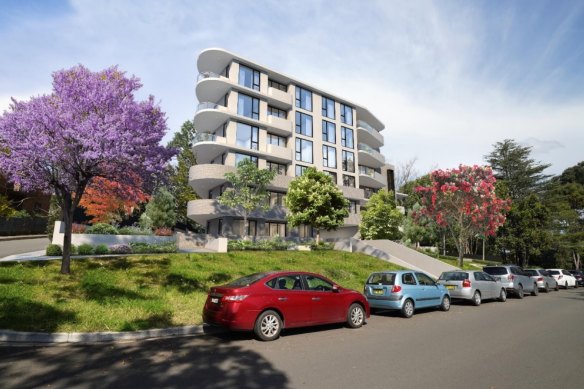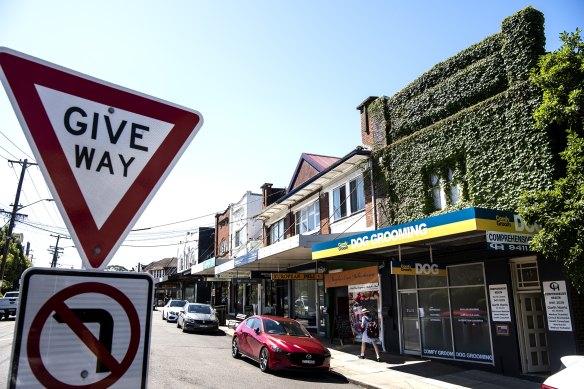By Michael Koziol and Anthony Segaert
A proposal to demolish two neighbouring houses in Lindfield to build 38 apartments over seven storeys is the first development application to be lodged under the state government’s planning reforms to allow more density around train stations.
It is so far the only DA that attempts to use the new Transport-Oriented Development program, and comes as a state parliament committee criticised the government for lacking transparency in how it developed the policy, including “rushed, poorly timed” consultation with key stakeholders.

The seven-storey apartment block in Lindfield was the first application lodged under the state government’s planning reforms.
The two houses were each purchased for more than $9 million between 2022 and 2023 at a significant premium: property records show one of the two was sold for $2.65 million in 2021.
There is an existing six-storey apartment block next door, and a five-storey building with 22 units was approved on the site by the Land and Environment Court in June 2023.
Planning Department deputy secretary Monica Gibson told a developers’ conference last week the government was very pleased to see the Lindfield application, which would be assessed by Ku-ring-gai Council.
The north shore council is suing the government over the TOD program in the Land and Environment Court, alleging the policy was improperly formed.

Roseville, one of four TOD suburbs within Ku-ring-gai Council, which is fighting the reform in court.Credit: Steven Siewert
“We had a joke in the office that wouldn’t it be amazing if the first [proposal] was in Ku-ring-gai LGA, and it was,” Gibson told the Urban Taskforce event.
“[This] is not just about improving affordability in Lindfield and in Ku-ring-gai, but it’s going to provide some much-needed housing diversity in that location as well.”
While the Lindfield proposal seeks to take advantage of the government’s new controls, it is in an area that was already zoned for high-density residential housing by Ku-ring-gai Council.
There have been other development proposals in the 21 active TOD suburbs, but the Planning Department confirmed the Lindfield proposal was the only one submitted as of October 2 which seeks to use the new planning controls.
The TOD reforms – which rezone land or change planning controls around train stations to allow greater density – create theoretical capacity for about 230,000 new homes over the next 15 years.
But speaking at the Urban Taskforce event TODs: Future or Failure last week, Gibson confirmed the department projected the program would only yield about 16,000 extra new homes in the five years of the National Housing Accord.
“It’s not the hero of the delivery of homes during the housing accord period,” she said, predicting already-planned and approved greenfield development would be the main driver.
“But … transport-oriented development is good long-term planning, and we’ll get some medium-term results during the housing accord period from that.”
TOD program ‘lacked transparency’
A state parliamentary inquiry into the TOD program found consultation on the plans was rushed and lacked transparency, and “clearly led to a perception that the NSW government was riding roughshod over local councils, and disregarding local knowledge and existing planning”.
The report was released on Tuesday by the Planning and Environment Committee, chaired by Greens upper house member Sue Higginson with members from Labor, the Liberals and the Liberal Democrats.
It said the consultation was “not supported by quality explanatory materials about the details and intentions of the reforms”, though conceded the process improved over time. The report also raised questions about the impact any developments would have on lowering house prices as the value of land in the zones would increase.
“The committee notes legitimate questions raised about the impact of a blanket rezoning approach on land values and housing affordability, and who benefits from the value created,” it said.
“There could be ways to share this value, such as through a greater government role in resuming land prior to development, or [the] introduction of a windfall tax scheme such as in Victoria and the ACT.”
Greens upper house member and committee chair Sue Higginson wrote in her foreword that sites were selected in an “opaque process” and that “local planning strategies, built over years of community input, [was] ignored”.
Planning Minister Paul Scully, responsible for the reforms, said the report was “another endorsement of the TOD program by the NSW parliament”.
“In April we arrived at local solutions in agreement with 12 of the 13 councils involved,” he said. “These local solutions will help to deliver some of the thousands of homes needed in NSW.”
Start the day with a summary of the day’s most important and interesting stories, analysis and insights. Sign up for our Morning Edition newsletter.